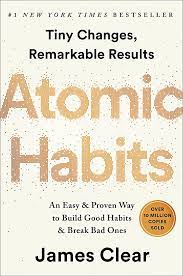The one-sentence summary
You can build good habits and break bad ones with hundreds of small decisions.
Can’t be bothered to read it? Too much screen time lately? Listen to the 5-minute podcast in two parts.
WHAT THE BOOK SAYS. 
- People think that when you want to change your life, you need to think big. In fact, it comes from the compound effect of hundreds of miniscule changes, which the author calls atomic habits – tiny changes that are easy to do that build into something much bigger.
- If you can get 1% better each day, you’ll end up with results 37% better after one year.
- We expect success to be linear but results are delayed so instead you face a valley of disappointment
- Goals are not as effective as systems because:
-
- Winners and losers have the same goals
- Achieving a goal is only a momentary change
- Goals restrict your happiness
- Goals are at odds with long-term progress
- You do not rise to the level of your goals. You fall to the level of your systems.
- Changing habits is challenging because (1) we try to change the wrong thing and (2) we try to change our habits in the wrong way. Identity-based habits are the most powerful because they focus on who you wish to become. Progress requires unlearning.
- The word identity comes from the latin essentitas (being) and identidem (repeatedly) – literally, your ‘repeated beingness.’
- All habits proceed through 4 stages:
- Cue. 2. Craving. 3. Response. 4. Reward.
- How to create a good habit: Make it obvious, attractive, easy, satisfying.
- How to break a bad habit: Make it invisible, unattractive, difficult, unsatisfying.
- Keeping a habit scorecard and stating an Implementation Intention is powerful: “I will (behaviour) at (time) in (location).” “When situation X arises, I will perform response Y.”
- Habit stacking reinforces a habit by linking it an old one: “After (current habit) I will (new habit).”
- Bad habits are autocatalytic: the process feeds itself.
- Self-control is a short-term strategy. A disciplined environment is much more long-term.
- Temptation bundling works by linking an action you want to do with an action you need to do.
- We tend to adopt the habits of three groups: the close (family and friends0, the many (tribe), and the powerful (those with status and prestige).
- Quality v. Quantity: quantity wins. Motion is the enemy of action – it looks like movement but isn’t as effective.
- In the beginning a habit requires a lot of effort but once it is automatic, it can be done almost without thinking. At this point, you have crossed the habit line. Mastering one habit requires this, mastering a field requires doing this repeatedly.
WHAT’S GOOD ABOUT IT
- To increase good habits, ask yourself these questions:
- What feels like fun to me, but work to others?
- What makes me lose track of time?
- Where do I get greater returns than the average person?
- What comes naturally to me?
- The Goldilocks Rule states that maximum motivation occurs when facing a challenge of just manageable difficulty. It’s the optimum level of arousal between boredom and anxiety. Psychologists call this the Yerkes-Dodson Law.
WHAT YOU HAVE TO WATCH
- Not much, but the book could be shorter because the points are pretty straightforward to grasp.
